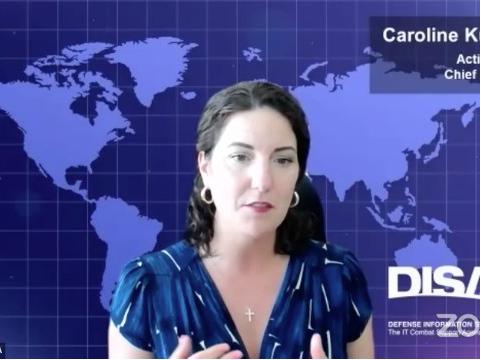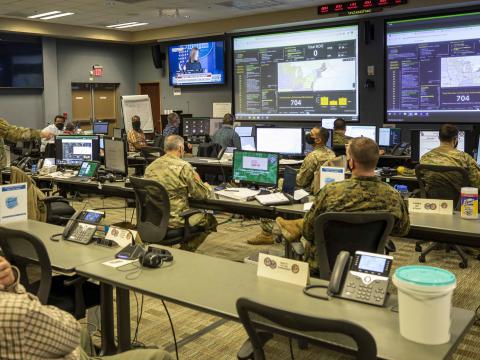Innovation Accelerates Military Readiness
From the back office to the front lines, technical tools the Defense Information Systems Agency is exploring will facilitate military-industry communications and collaboration.
By enhancing the U.S. Department-industry relationship, future capabilities will expand how cloud technologies are deployed and employed and will improve warfighter readiness, bringing the latest tactics for open communications to mission owners.
Leading up to Technet Cyber 2022, agency directors are sharing their insights during weekly webinars, detailing recent leaps in technology adoption and, more importantly, explaining how industry can get their solutions into the military mainstream. During this week’s webinar, leaders talked about how innovation is driving force readiness.
Today’s tools assist Defense Information Systems Agency (DISA) personnel to better serve its partners. Automation improves the back-office process, which helps agency personnel to push contracts through the process faster and more accurately and cloud technology enables the services to buy products directly from contractors using a standardized format.
Steve M. Wallace, chief technology officer, Emerging Technology Directorate, Enterprise and Innovation Center, Defense Information Systems Agency (DISA), spoke about how the recent realignment also has helped the organization meld its teams’ various strengths. The result has been solutions—within the agency as well as with industry partners—that offer the comprehensive solutions military service members will need to fight future adversaries on land, in space and in cyberspace.
DISA’s previous construct comprised two centers: business development and sustainment. Wallace pointed out that while that configuration may work for building battleships, it isn’t the best way to bring and sustain leading-edge technologies into the military. “IT needs to be evergreen because if it's not, it's effectively dying. So, we moved to a flatter construct,” he stated.
The agency’s previous organizational structure comprised two centers: operation and development. Now, it not only includes two additional centers—financial and human resources centers—but also blended operational and development elements across all four centers. This construct reduces some of the layers of leadership and facilitates more direct engagement across the management level, Wallace explained. “That also increases the speed of information flow, and I think that's the overall intent of trying to flatten out the organization,” he said.
In addition to improving communications among the agency’s departments, DISA continues accelerating its outreach to companies, and in an ironic twist, it was the response to COVID-19 that continues to provide one of its most effective tools.
Carlen Capenos, director, Office of Small Business Programs, DISA, related that the expanded availability of cameras and use of video for meetings enhanced communications with industry. Although the agency’s personnel strived to interact with firms in various ways in the past, the substantial use of video meetings within both DISA and the commercial sector ironically enabled many more face-to-face meetings during the pandemic and today.
“While we were postured better than some other organizations to switch rapidly [to videoconferencing], once we got the cameras and once teams became stable on the bandwidth, it just tenfold increased our ability to talk, to engage, to provide the information to the small businesses.
“Our role is to make sure that we go to the places virtually, and [video has] allowed us to do more webinars like this one and to do more Small Business 101 orientations. [Cameras have allowed us] to increase our ‘one-on-ones’ and provide that education part to small businesses and large businesses,” Capenos shared.
The increased availability, use and acceptance of video meetings as viable means of communications enables her team to respond quickly to innovators who inquire about how to work with DISA as well as understand the agency’s and military services’ problems and priorities. Consequently, small businesses know when DISA is seeking specific solutions and can learn about how to get past the barriers to entry for opportunities they want to seize, Capenos emphasized.
But the small business team does more than meet virtually. Capenos’ organization is holding an all-day business match event on April 25; interested companies can obtain additional information by emailing DISAsmallbusiness@mail.mil.
Both large and small companies have been helping the agency grow its cloud capabilities, some involving both artificial intelligence and machine learning. Jason Abernathy, 4th estate user engagement principal at DISA’s Hosting and Compute Center, known as “the hack,” explained that these capabilities lay the foundation for departmental strategic initiatives.
“Artificial intelligence and machine learning will be available at all classification levels reaching from headquarters to the tactical edge; however, we understand that the need for a hybrid cloud strategy that includes DoD cloud now—off-premises cloud—should be the target environment for many workloads,” Abernathy explained.
In addition to the need to develop on-demand cloud access capabilities, the Defense Department’s “enduring requirements” for cloud are becoming too outdated to be compatible with cloud technology, he allowed. As a result, his team must consider all environments and areas of operation when addressing how to meet today’s needs while preparing for tomorrow’s.
For example, in the OCONUS space, Abernathy’s team is meeting mission readiness by standing up Stratus, now in the pilot stage, as a hybrid cloud solution. “We work with our mission partners to make sure that the solutions we're providing will allow them the flexibility to move either on-premises or off-premises,” he stated.
While agency teams work on finding or providing capabilities to warfighters in various locations, they also must bear in mind that their mission partners are part of a joint community. Consequently, the tools they offer not only must work for each of the services but also be interoperable once brought into the office or battlespace.
To ensure compatibility, Capt. Robert Matthias, USN, currently is examining several potential solutions to ensure flexible communications capabilities throughout the services and with allies.
Capt. Matthias explained a few of DISA’s Joint Interoperability Test Command current projects include Thunderdome, the agency’s zero-trust cybersecurity initiative, which moves the military away from the castle-and-moat approach to protecting data, and Joint All-Domain Command and Control 2, a concept that not only brings all sensors from the military services into a single network but also addresses electromagnetic spectrum enterprise architecture protections.
The four-part webinar series tees up AFCEA’s TechNet Cyber event, April 26-28 in Baltimore, and provides an opportunity to learn how you can support the nation’s cyber mission. Be sure to catch the last session on April 13, which takes place live at 1 p.m. ET. Missed an earlier webinar? No problem. You can view them on demand. One registration provides access to all live and recorded sessions.




Comments